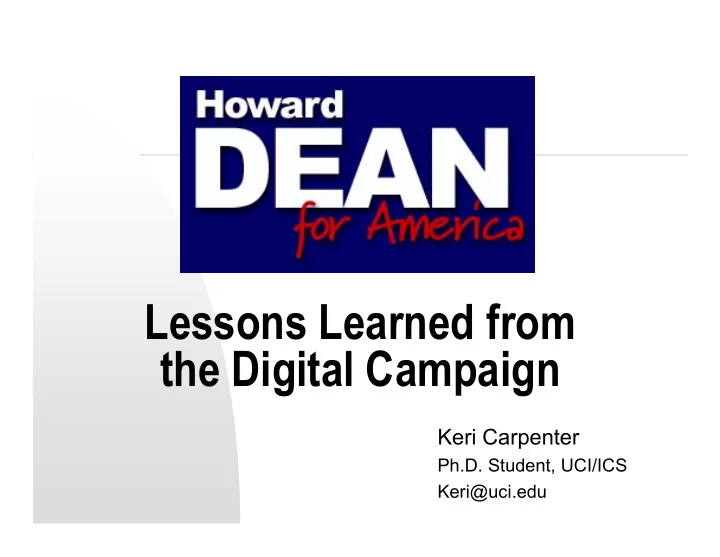

Lessons Learned from the Digital Campaign Keri Carpenter Ph.D. Student, UCI/ICS Keri@uci.edu
What I did Spent 3 months at “Dean for America” National Headquarters in Burlington, VT from November 2003 to February 2004 “embedded researcher” Volunteered and worked with the “webteam” – 25 person group which managed all online efforts within the campaign: programming, administration, writing on the blog, mass emails, etc.
Traditional Campaigning
Online Campaigning
Dean for America Campaign January 2003 to February 2004 (13 months) The first “Internet” political campaign
Why do we say it was the first Internet Campaign? In contrast to previous campaigns, it was less about creating an online presence (brochure website) More about creating an online social movement using online networking tools (blog, meetup, lists, etc.) Opened up control of the message Trusted, accepted and expected their supporters to craft the movement
How did it become the “Internet” campaign? Joe Trippi, campaign manager Veteran of 90’s era dot-com ventures Wanted to run an “open source” campaign and advocated a “netroots” orientation for the campaign Believed in the power of opening up the conversation and the message Cathedral and the Bazaar in National Politics?
Online Landmark April, 26 th 2003 – anniversary of signing the Civil Unions bill into law in Vermont 1 Week Before – Senator Santorum’s anti-gay remarks before the Associated Press Email petition sent out to Dean’s email list to: Condemn the remarks – ask for resignation Contribute to the campaign adding 26 cents
Online Landmark Received 12,000 signers to the petition and increased Dean’s email list $25,000 in the 3 days following the email at a time when they would have received $6,000
Online Landmark Secured a deep, enduring belief within the campaign That online efforts would: Attract supporters + Raise funds
The Tools (Under the Hood) Website – CMS Convio and Bricolage Contribution Engine – Convio & internal engine Mass Email Engine – Convio and Lyris
The Tools (Online Organizing) Blog – Blogger and Moveable Type Meetup.com – external ASP DeanLink and GetLocal–Internally programmed And thousands of creative, supporter generated campaign materials and events (websites, email groups, postcards, flyers, meetups, socials, houseparties, victory day parties, debate watching parties, etc.)
tax-hiking, government-expanding, latte-drinking, sushi-eating, Volvo-driving, New York Times-reading, body-piercing, Hollywood-loving, http://www.takeyourcountryback.com left-wing freak show
http://www.takeyourcountryback.com
http://www.switch2dean.com
Blog Readership Growth The Blog 100000 80000 60000 40000 20000 0 May July Sept Jan Blog provided up-to-the minute articles and discussion of campaign activities Central online interactive “community” for the campaign During the period Oct. 15 th to Feb. 4 th , received an average of 2722 comments per day On high days, the number was over 6,000
Opening up the Dialogue The campaign didn’t control the message Encouraged the creation of independent and autonomous content They freely linked to independent websites (without vetting their content) Encouraged the creation of independent email communities (without any oversight) For instance, the blogroll contained 394 websites
What did all this openness accomplish? Took a Candidate, a governor from an obscure state, who had, in January 2003 … 432 known supporters and $157,000 in the bank To a “real” contender for the Dem Nomination for presidency
What did this openness accomplish? Raised over $50M by over 300,000 individuals Over 640,000 supporters on main mailing list Over 189,000 participants in monthly Meetups Over 700 grassroots websites in support Over 1000 Yahoo! Groups and listservs Over 35,000 blog commenters
What did it cost? For about $1M and 25 people in whole team (not all paid) Brought in approximately $28-$30M in online contributions (out of $50M total)
What does this mean for the future? Kerry and Bush both had online “presences” but never achieved an online movement Opening up the message and the campaign to bring in the talent of supporters appears to be key to a successful online campaign However, online success has not (yet) been able to propel a candidate to voting success so campaigns should assess the effort they place on their online presence
If you want the talent: EchoDitto.com – comprised by Nicco Mele, Webmaster, Harish Rao (Database), Michael Silberman (Meetups), Jim Brayton (Designer), Garrett Graff (Press), Carey Havrilko (Database) BlueStateDigital.com – Jascha Franklin-Hodge, System Administrator, Clay Johnson (Commons), Joe Rospars (Blogging), Ben Self (Database), Roy Neel (Campaign Manager), CivicSpaceLabs.com – Zack Rosen (Lead Programmer) Blackboxvoting.com --
Traditional Campaigning
Accomplishments What tools are being used to stimulate online participation? What is the efficacy of these tools, if any?
Research Questions – circa Nov. 2003 What tools are being used to stimulate online participation? What is the efficacy of these tools, if any?
The Lessons (in 30 seconds or less) WebTools can DRAMATICALLY lower barriers to participation/action – beyond company, team investigation Great Tools (website, blog, Meetups) are NECESSARY but not ENOUGH Provide tools with CLEAR MESSAGE Which preciptates MOMENT OF ALIGNMENT Which leads to CONTEXTUAL ACTION Provide suppoters with myriad of tools and methods to promote ACTION – on and off-line Allow community to take AUTONOMOUS ACTION and RECOGNIZE THOSE EFFORTS
Recommend
More recommend